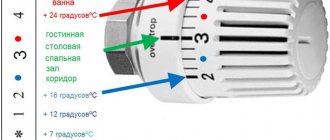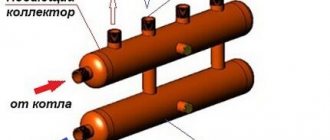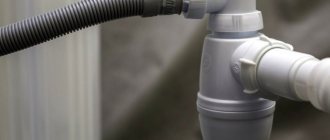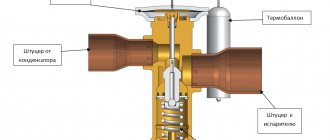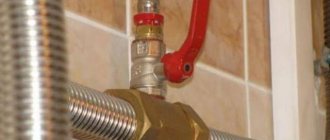Since chasing cast iron pipes is a very labor-intensive job, as any specialist will tell you, it is wiser to carry out preventive inspections than to wait until a large-scale repair of the sewer system is required. Since for external sewer networks cast iron is still mainly used as the main material for pipes, which cannot yet be completely replaced with modern plastic analogues, one should pay special attention to prevention. In our article we will talk about two types of pre-repair and post-repair work - caulking and caulking of cast iron pipes.
Cast iron joint made by caulking
Caulking of cast iron pipes
Preparation for repair
Sometimes it becomes necessary to repair some part of the sewer system. However, such repairs cannot always be made without disconnecting the pipes. When it is necessary to replace a section of a pipeline, you should first inspect the site of future work to determine how the pipes were connected to each other at one time.
Often the main difficulty is that pipes, especially those located in the ground, are filled with a special compound that prevents their separation. In this case, the question arises of how to caulk a cast iron pipe without much effort and time.
Dismantling of pipes is carried out with extreme caution
Pipe caulking technology
Do-it-yourself caulking of cast iron pipes, carried out when replacing a riser or changing a toilet, can create no less of a problem. In this case, it becomes necessary to caulk the cast iron pipe pipe as carefully as possible. The caulking process looks like this:
- The first action that needs to be taken is to tap the pipe socket with a hammer, being careful not to split it, in order to avoid a complete replacement of the riser.
- After making sure that the bell moves quite freely and can be released without any problems, since it was caulked using a heel, you can begin dismantling:
- slightly loosen the bell from side to side;
- pry it out with a screwdriver and pull the rope out a little;
- grab the rope tightly with pliers;
- carefully, slowly, pull out the rope while continuing to loosen the tube.
The heel must be pryed and pulled out
- In the case when the bell does not budge after tapping, that is, the caulking of cast iron pipes was carried out by pouring sulfur, you will have to use the method of burning it out:
- carefully heat the pipe in a circle using a blowtorch or burner;
- trying not to damage the pipe, continue to gently tap the pipe with a hammer;
- when the bell starts to move, slightly loosen it from side to side using an adjustable wrench.
- After the bell is safely released, it must be cleaned using a chisel or chisel. Particular care should be taken to clean the bell seat where the sealing rubber will be placed.
- Coat the rubber sealing ring with special lubricant and insert it into the socket.
- Install a new part into the seal.
O-ring inserted into the socket
Video of the embossing process
How to caulk cast iron pipes is done - the video below will show you even more clearly.
—
CONDITION 1
RESULTS ¿ÑоизводиÑÑÑÑбез пеÑеÑÑва. â
| RESULTS. â |
RESULTS RESULTS. â
RESULTS RESULTS ÑÑмом. â
RESULTS SMALLERY CONTENTS ³Ð¾ ÑеÑÐµÐ½Ð¸Ñ Ñ Ð·Ð°Ð¾ÑÑÑеннÑми конÑами диамеÑÑо м Ð¾Ñ 6 до 20 мм в завиÑимоÑÑи Ð¾Ñ ÑолÑÐ¸Ð½Ñ Ñва. RESULTS 7 — 10 Ñм дÑÑг Ð¾Ñ ROCK. 30 - 40 мин Ð ¿Ð¾Ñле Ñкладки беÑона. â
RESULTS ASSURANCE RESEARCH SOLUTION, ASSURANCE › онÑÑÑÑкÑий. â
RESULTS RESULTS давÐ" ›››› the и беÑоне. â
| RESULTS. â |
RESULTS µÐºÐ°Ð½ÐºÐ¾Ð¹ ÑÑÑка ÑеменÑом обеÑпеÑиваÑÑ Ð¶ÐµÑÑк ое, но ÑÑÐ¾Ð»Ñ Ð¶Ðµ ROOM ASSURANCE ASSURANCE. â
| RESULTS RESULTS. â |
С¡µñ eth ° ð¿ ¿° ° ð² ¿¿¿ðµuzzi ð² ñµuzza ðices ðð porn ° ñððәavyorth · м page, ð ° ñ ° 𶶵 ñð ¸ ROOM Ñ Ð³ÑÑнÑовÑÑ Ð²Ð¾Ð´. RESULTS »ÐºÐ¸ ÑÑÑков нелÑзÑ. â
ROOM ¸ÑÑое железо ( зинÑеÑиÑ) Ð´Ð»Ñ Ð·Ð °Ñеканки ÑÑÑков ÑÑÑбопÑоводов. RESULTS registry °Ð½Ð¸ÐµÐ¼ пÑи 1200 — 1350 С без пÑедваÑиÑелÑного пÑÐµÑ RESULTS RESULTS ¹ÐºÐ¾ÑÑи. RESULTS RESEARCH ¶Ð½Ñми поР»Ð¾Ñами, и пÑедÑÑавлÑÐµÑ Ð¸Ð· ÑÐµÐ±Ñ Ð»ÐµÐ½ÑÑ, коÑоÑÑÑ Ñ RESULTS ·Ð°Ñеканке SAS± â
| RESULTS. â |
RESULTS + ROCK, нÐ2 ROLLING UP. regurgitation RESULTS ±Ð¾Ð¿ ASSURANCE RESEARCH ½ÑÑ ÑÑÑб. â
RESULTS · ¾Ð»Ñко двÑÑбÑÑÑнÑе мÑÑÑÑÑ, нÐ2 ROLLING UP. ROOM ¼ÐµÑиÑеÑком оÑноÑении они не менее надеР¶Ð½Ñ, Ñем ÑоединенР© I'm sorry. â
Pipe caulking
When assembling a system consisting of cast iron pipes, it is necessary to provide in advance a method for sealing the gaps that invariably remain between the outer side of the inserted part of the pipe and the inner surface of the socket. That is, you should think about how to mint cast iron pipes. There are two possible ways to solve the problem; let’s consider them in more detail.
Sealing sockets with cement mixture
The caulking technology looks like this:
- Installation of resin seal.
- caulk a rope of resin into the socket up to 2/3 of its depth;
- When forming the first rope ring, wrap the end of the rope over the ring so that it does not fall into the pipe.
- Use of cement mortar.
- Mix cement marked 300-400 with water (by weight) in a ratio of 9:1;
- fill the remaining space in the socket after compacting the bundle with cement mortar;
- stamp the cement tightly with a hammer and until the stamping bounces off the cement;
- For better setting of the solution after caulking, cover it with a wet rag.
To increase work productivity, it is worth using widened caulking and caulking, which speeds up the process by about 30%.
Tool for sealing socket pipes
Sealing sockets with asbestos cement
Another way to caulk a cast iron pipe is to use an asbestos-cement mixture. The process has two differences:
- A dry mixture of asbestos fiber and cement is prepared by mixing them in a ratio of 1:2.
- Before direct use, the dry mixture is moistened with water: from 10 to 12% of the initial mass of the mixture.
The caulking technology itself looks similar to the first method.
Scheme of minting with asbestos cement
This completes the rather labor-intensive work of caulking and/or caulking of cast iron pipes. To achieve the best result, you should, however, entrust such work to qualified specialists. Only in this case can you be sure that everything will be done correctly, and you will not have to deal with more complex repairs, eliminating the flaws of poor installation or dismantling.
Sealing socket joints of cast iron sewer pipes with hemp strands and cement or asbestos-cement mixture.
The hemp strand intended for filling the socket gap must be tarred. Before sealing connections, the smooth ends of the pipes and sockets must be cleaned of dirt. Before insertion into the bell-shaped slit, the strand is twisted into a rope with a thickness slightly larger than the width of the slit (7-8 mm) so that it fits tightly into it.
The ends of the bundle should not protrude into the pipe. The strands laid in a bell-shaped slot are compacted (caulked) with strong blows of a hammer on the caulk. Caulk the gap with two or three strands, the ends of which should overlap by 10-15 mm.
The strand compacted in the socket gap should not reach the outer end of the socket by 30 mm to allow subsequent filling of the socket joint with cement or asbestos-cement mixture. For better adhesion to cement, it is recommended not to resin the last turn of the strand. [p.257] Notes I.
Consumption rates for gasket and welding materials, as well as sulfur and cement, are given based on 100% of each type of material. When using several types of gasket and welding materials, as well as various materials for sealing socket joints of cast iron sewer pipes and fittings, the percentage of each of them is first determined and then the need for each type of material is calculated. [p.393]Asbestos cement is a mixture of asbestos and cement.
The composition of the mixture is asbestos No. 5 or No. 6 - 30% by weight, Portland cement grade 350-400 or fast-setting (expanding) - 70% by weight and water - 10-12% by weight of the asbestos-cement mixture. Slabs, pipes, and sheets are made from asbestos cement. Asbestos cement is also used for sealing socket and coupling joints of cast iron and asbestos cement pipes, mainly in the construction of water pipelines.
Asbestos cement can be used instead of lead as a sealing material and when connecting cast iron gas pipelines. The rigidity of such a bell is somewhat greater than that of a lead one. In addition, the resistance of cement against corrosion by impurities contained in gases has not yet been sufficiently studied.
[p.11]S 23. SEALING FLARE JOINTS OF CAST IRON PIPES S3> [p.83]Cast iron pipes and parts are manufactured with a socket butt joint O, 50... 1200 mm - with sealing strand 3 (Fig.
24, a) and asbestos-cement mortar 2, and Wu 65...300 mm - using a rubber sealing collar 5 (Fig. 24, b). Socket butt joints with a sealing collar are flexible and equal in strength to the pipe, ensuring the tightness of the pipeline with axial movement up to 15 mm and angular deformation up to 3...4°.
Alternatives
ductile iron
First meeting
Under this abbreviation lies the so-called high-strength nodular cast iron.
To explain the meaning of the term, we need to delve briefly into the jungle of physics.
- All the main differences between cast iron and steel - brittleness, low ductility and high resistance to corrosion - are determined by the presence in it of one of the forms of carbon - graphite.
- Ordinary graphite has the appearance of miniature flat flakes. However, during recrystallization, which occurs when certain additives are introduced into the gray cast iron melt (in particular, magnesium and its compounds), it changes its shape to spherical.
- At the same time, the physical properties of the metal change significantly: it acquires toughness, ductility and resistance to impact loads, while maintaining corrosion resistance.
What’s especially nice is that the price of a ton of material changes slightly during transformation. The total proportion of additives causing carbon recrystallization does not exceed 0.08% by weight of cast iron.
Bell-shaped water pipes made of ductile iron are today the main alternative to gray cast iron.
- They are superior in compressive and bending strength to cast iron, not to mention all types of polymer pipes. Accordingly, water supply lines can be laid with ductile iron pipes under busy highways and on unstable soils. They have all the qualities of steel, except for their Achilles heel - low corrosion resistance.
- The problem of labor-intensive and low-tech embossing of bells has been completely solved. Instead of embossing, sockets with ring rubber seals are used. Of course, with significant pipe sizes, assembly of sockets requires the use of heavy equipment; however, the mass of these pipes in any case will not allow installing the pipeline manually.
Normative documents
The production of pressure pipeline elements from ductile iron is regulated by a separate standard - GOST R ISO 2531-2008.
Let's highlight its key points.
- According to the document, pipes and fittings can have nominal sizes from 40 to 2600 millimeters, which allows the use of ductile iron to create highways that supply entire cities.
- The composition of the metal, according to GOST, should not have a harmful effect on the composition of water.
- The length of pipes is regulated by the standard depending on their nominal diameter:
The maximum permissible curvature is no more than 0.125% of the pipe length.
Depending on the operating conditions, the following can be used as an external coating for the pipeline:
- Metal zinc.
- Zinc paint (zinc powder in a polymer binder).
- Polyethylene.
- Polyurethane.
- Fiber cement.
- Adhesive polymer tape.
- Epoxy resin.
- Bituminous mastic or paint.
For internal protection of pipes and fittings, it is permissible to use:
- Cement mortars (Portland cement, Portland slag cement and aluminous cement).
- Polyethylene.
- Polyurethane.
- Epoxy resin.
- Bitumen paint (mastic).
The marking of pipeline elements must indicate:
- Manufacturer (name or trademark).
- Year of manufacture.
- Indication of material (ductile iron).
- Nominal size.
- The standard to which the product is manufactured.
Polyethylene
Polyethylene pressure pipes are the main alternative to cast iron water supply today.
A detailed acquaintance with them clearly goes beyond the scope of our material, so we will pay attention only to their key properties.
- The service life of polyethylene is estimated to be years. In practice, this material can be considered almost eternal.
- In principle, there cannot be deposits on the walls that reduce the lumen of the pipe. The smooth surface of the polymer with extremely low adhesive qualities simply will not allow a blockage to form.
- All connections are made by butt welding. The strength of the joint is at least 80% of the strength of a solid pipe.
The only complaint about polyethylene that allows cast iron pipes to remain on the market to this day is its high ductility and, as a consequence, very moderate ring stiffness. A polyethylene main pipeline can be laid in deformable soil only with protection by a reinforced concrete gutter.
Precautions for repairing cast iron pipes
When working with such pipes, be sure to remember that cast iron, despite its durability, is a relatively brittle material. If you hit it sharply or too hard with a metal hammer, the wall will begin to vibrate, which may cause cracks to appear. If this happens, replacing the damaged sections will be time-consuming and expensive. Therefore, when preparing for dismantling, stock up on the necessary tools in advance.
You should not work alone, it is unsafe and difficult. Better call someone for help.
It is important to know that sulfur fumes can be harmful to health, so use a gas mask, or, in extreme cases, a respirator and safety glasses. Also make sure there is good air circulation in the room where renovation work is taking place.
After removing the pipe from the socket, take time and attention to clean the seat of this part. This will ensure that the sealing material is installed without defects or distortions.
Immediately pack all dismantled material and debris into construction bags, tie them up and throw them away. An old pipeline will emit an unpleasant odor.
If you are caulking cast iron pipes for the first time and, after reading this article, still do not understand how to do it, be sure to contact a professional. For an experienced master, the process of dismantling cast iron pipes will take 25-30 minutes, while a beginner can spend more than 3 hours and with an unknown result.
This article will look at the caulking of cast iron pipes - what this procedure is, how to prepare for it and prevent the need for it, and also provides an example of caulking using the example of a cast iron pipe. Cast iron is a material with very high strength, and also a lot of weight. The density of the structure makes it possible to make massive and strong products from it that can withstand significant loads, which is why cast iron pipes are used as elements of water supply and sewerage systems. Pipe caulking Even taking into account the development of chemical production and the active use of pipes from various types of plastic, when laying external water supply systems more often In general, cast iron is used as a more serious material. Cast iron sewer pipes are usually used in the construction of sewerage systems with very large loads, significantly exceeding household loads. Buildings of catering establishments, factories that process meat and other animal products, etc.
constantly create a stream of waste, which quite often leads to ruptures of cast iron pipes, which should be repaired immediately. And taking into account the fact that chasing and minting cast iron pipes is quite difficult, experts recommend annual scheduled inspections to avoid labor-intensive repairs. Home and the sequence of repairs Caulking a cast iron pipe You have to think about how to caulk a cast iron pipe if it is necessary to replace an element and it is impossible to correct the damage directly at the scene of the accident. First of all, they carry out preparatory work, that is, they carefully inspect the pipes and figure out exactly how they are welded to each other friend. Quite often you have to deal with pipes filled with a special solution used to glue their parts together. In this case, while underground, the elements can grow together so tightly that they cannot be disconnected without applying force. In this case, experts recommend using a gas cutter, which allows you to quickly remove the fastening compound and disconnect the pipes. When talking about caulking a cast iron pipe, it should be borne in mind that the work will not be easy and will require turning off the water in the entire house or even the area if an important area is being repaired. The preparation of the pipe for repair is carried out using special tools: The damaged or burst section is cut off with a grinder; A new part of the pipe is installed in place of the damage; The seam is closed with a construction bandage with cement. Preventing the occurrence of a problem Example of caulking It should be borne in mind that despite all the excellent physical qualities, cast iron is a rather fragile material .
It is deformed under the influence of water and the chemical reactions that occur in it, so the pipes are affected by all changes, including changes in temperature, which makes them fragile and unable to withstand high pressure. Chasing cast iron pipes is a rather complex process, the quality of which includes replacement element of the pipe, also leaving a certain margin for its expansion. The new part of the pipe is inserted into the socket, after which the seam must be securely secured using a resin strand. To tightly lay and secure the threads, a tool such as a caulk is used. Practical experience shows that the formation of cracks in cast iron water pipes is only part of the problem, which grows if decisive measures are not taken. Patching holes with special compounds helps temporarily, but sooner or later replacement will still be required, so it’s easier to deal with the damage right away. Caulking a cast iron pipe Correct caulking When replacing a sewer riser, a deck chair from a common riser, a toilet, etc.
many have encountered the problem of caulking a cast iron pipe. It turned out that the procedure is not as simple as it seems. Let's take a closer look at the process of caulking a cast iron pipe: First, carefully tap the socket with a hammer, making sure not to break the sewer socket entering the riser or going out to the neighbors, which will require an expensive replacement of the entire riser. Branch pipe If the socket is loose and gives in, it means that the caulking of the pipes was done in the old way using a rope and a cambola: At the same time, they begin to loosen the socket in different directions; Pry up the rope with a screwdriver; Grab the rope with pliers; Slowly pull out the rope, loosening the socket. If the bell sits firmly, which means that it is most likely filled with sulfur and knocking on it is useless.
In this case, using a torch or blowtorch, start in a circle. In this case, you should also be careful and avoid damaging the bell. Important: when burning sulfur, you should definitely wear a respirator, since this procedure causes significant harm to health, including death. When burning out sulfur, you should continue to tap with a hammer until the bell begins to move from place. Next, using an adjustable wrench, loosen the bell left and right, sometimes pulling it towards you. After removing the bell, use a chisel, pry bar or chisel to clean its seat in order to insert the sealing rubber smoothly and without distortions. Cover the rubber with silicone and insert it into socket. A plastic part, such as a tee, is inserted into the elastic band. At this point, the caulking process is completed; given its complexity and labor intensity, it is better to entrust this work to qualified specialists. This not only guarantees high-quality and correct caulking, but also protects against problems such as destruction of the socket and, as a consequence, replacement of the entire riser.
—
CONDITION 1
RESULTS ¿ÑоизводиÑÑÑÑбез пеÑеÑÑва. â
| RESULTS. â |
RESULTS RESULTS. â
RESULTS RESULTS ÑÑмом. â
RESULTS SMALLERY CONTENTS ³Ð¾ ÑеÑÐµÐ½Ð¸Ñ Ñ Ð·Ð°Ð¾ÑÑÑеннÑми конÑами диамеÑÑо м Ð¾Ñ 6 до 20 мм в завиÑимоÑÑи Ð¾Ñ ÑолÑÐ¸Ð½Ñ Ñва. RESULTS 7 — 10 Ñм дÑÑг Ð¾Ñ ROCK. 30 - 40 мин Ð ¿Ð¾Ñле Ñкладки беÑона. â
RESULTS ASSURANCE RESEARCH SOLUTION, ASSURANCE › онÑÑÑÑкÑий. â
RESULTS RESULTS давÐ" ›››› the и беÑоне. â
| RESULTS. â |
RESULTS µÐºÐ°Ð½ÐºÐ¾Ð¹ ÑÑÑка ÑеменÑом обеÑпеÑиваÑÑ Ð¶ÐµÑÑк ое, но ÑÑÐ¾Ð»Ñ Ð¶Ðµ ROOM ASSURANCE ASSURANCE. â
| RESULTS RESULTS. â |
С¡µñ eth ° ð¿ ¿° ° ð² ¿¿¿ðµuzzi ð² ñµuzza ðices ðð porn ° ñððәavyorth · м page, ð ° ñ ° 𶶵 ñð ¸ ROOM Ñ Ð³ÑÑнÑовÑÑ Ð²Ð¾Ð´. RESULTS »ÐºÐ¸ ÑÑÑков нелÑзÑ. â
ROOM ¸ÑÑое железо ( зинÑеÑиÑ) Ð´Ð»Ñ Ð·Ð °Ñеканки ÑÑÑков ÑÑÑбопÑоводов. RESULTS registry °Ð½Ð¸ÐµÐ¼ пÑи 1200 — 1350 С без пÑедваÑиÑелÑного пÑÐµÑ RESULTS RESULTS ¹ÐºÐ¾ÑÑи. RESULTS RESEARCH ¶Ð½Ñми поР»Ð¾Ñами, и пÑедÑÑавлÑÐµÑ Ð¸Ð· ÑÐµÐ±Ñ Ð»ÐµÐ½ÑÑ, коÑоÑÑÑ Ñ RESULTS ·Ð°Ñеканке SAS± â
| RESULTS. â |
RESULTS + ROCK, нÐ2 ROLLING UP. regurgitation RESULTS ±Ð¾Ð¿ ASSURANCE RESEARCH ½ÑÑ ÑÑÑб. â
RESULTS · ¾Ð»Ñко двÑÑбÑÑÑнÑе мÑÑÑÑÑ, нÐ2 ROLLING UP. ROOM ¼ÐµÑиÑеÑком оÑноÑении они не менее надеР¶Ð½Ñ, Ñем ÑоединенР© I'm sorry. â
Preparation for caulking cast iron pipes
People usually call a professional to caulk a cast iron pipe. However, such work can be done with your own hands. It is very important to act carefully.
Pipe caulking is the separation of sewerage pipeline elements. This process requires care and precision, but it is quite possible to carry it out on your own.
Caulking sewer pipes requires careful preparation. The main stages of this process:
- First of all, you need to prepare your tools. We are talking about a grinder, a hacksaw, a simple and rubber hammer, a chisel, an adjustable wrench, screwdrivers, pliers, a respirator and a blowtorch.
- We need to dig up the valves. This will prevent liquid from flowing through the pipe being worked on.
- You should also ask your neighbors not to use the water and sewer systems. We should talk especially seriously about using the toilet. After all, this can lead to sewage falling right on your head.
- You will have to dismantle the toilet, sink, or the system whose sewer part you are going to mint.
Pipe caulking can only be done when you have completed all the stages of preparation for this process. Otherwise, you simply will not be able to cope with this process.
Preparatory work
Products are checked for defects. External characteristics are assessed: the pipes should not have dents, cracks, bumps or stains. It is recommended to use communications characterized by a smooth wall surface. You can lightly tap the products. The sound should be the same in different places. The condition of the cut is also assessed. Its structure should be uniform, fine-grained.
If you plan to replace cast iron pipes, you must first dismantle the old communications. For this purpose, prepare a hammer (for horizontally oriented products) and a grinder. The riser is cut only using a grinding machine. It is not recommended to use a hammer in this case, since individual parts may fall into the lumen of the pipe, which will lead to a blockage that is difficult to remove. Before installing communications, it is necessary to shut off the water riser. If the toilet connection is changed, you should not use the flush for some time.
Cutting off an unnecessary section of pipe
If you want to repair or replace a sewer or water pipe system, you need to carry out each step step by step. After all, this process is different in that if it fails, you can damage your neighbors’ sewer system.
Chasing a toilet outlet is difficult because in order to dismantle this element of plumbing, it will have to be broken. It will not be possible to remove it whole.
Before you begin caulking the sewer system, it is necessary to repair the damaged area. There are several recommendations for this case.
The first stage of caulking cast iron sewer:
- The end pipe is very easy to replace. Here you won’t have to do any special work other than the caulking itself.
- If you want to replace the central part of the sewer riser, then this will be more difficult. Here you will have to make a cut.
- Four centimeters from the common pipe, make a cut in a circle. Use a protective mask, goggles and gloves.
- The unfinished part is carefully finished with a hacksaw. It is not recommended to hit the pipe with a hammer. The fact is that the fragility of metal is unpredictable; upon impact, instead of a damaged pipe, the required part may burst, and in this case, the next element will have to be replaced.
- We tie a large piece of rags to the pipe, then stick it into it. This is necessary to prevent foreign objects from getting into the riser.
- Now they go down some distance from the cut along the damaged element so that there are 20-30 centimeters left to the point of caulking, and we make a new cut. Carefully remove the cut piece.
- The hole in the pipe is again covered with a rag.
When cutting a pipe, all actions must be performed very carefully. Do not cut the product flush, as this increases the danger of work.
It is very convenient to do such work together with a friend. Then one person can hold the element to be cut, and the other can cut.
Brands and manufacturers of PPM
Manufacturers of PPM are companies specializing in fire protection. Fire resistance parameters for cuffs and sleeves are in the range: EI 90 – 180 (standard 120 – 180), in special cases – 240, operating temperature -40 to +95 °C, service life 25 – 30 or more years without maintenance.
Certificate of conformity is required. The marking often contains the letter R, indicating pipe entries, for example, the R 90 cuff of the REHAU PLUS system.
| Brand | Model | Expansion coefficient | Expansion temperature (+°C)/start (sec.)/full sealing (min.) |
| Hilti |
| 1:4 1:17 | 210 – 250/15/3 – 4 |
| Rehau | RAUPIANO PLUS | 1:17 | 200/10/3 – 5 |
| Geberit | Geberit RS90 Plus | 200/15/4 | |
| BIS | BIS Pacifyre MK II | 140/10/4 | |
| RTMK | RTMK-25 – 200 | 170 – 200/15/2 – 5 | |
| Ognez | Ogneza-PM 16, 20, 25, 32, 40, 50, 65, 80, 90, 110, 125, 160, 200, 225, 250 | 900% | 150/15/4 |
| Aegis | Egida-PM 20 – 200 | 200/10/up to 14 | |
| Fire barrier | Firebarrier-MP 16 – 160 | 120/15/4 | |
| Baltika | Baltika-PM 16 –250 | 120/15/7 | |
| Ostendorf | BS HT Scolan | 120/15/2 – 5 |
PB certificates for enclosing fire-resistant units for pipes: Download: Hilti CP 643 N.pdf Download: Hilti CP 644.pdf Download: Baltika PM.pdf Download: Firebarrier MP.pdf Download: Ogneza-PM.pdf Download: RTMK.pdf
Methods for caulking pipes and options for its neutralization
Embossing a pipe, that is, connecting its elements, can be done in three ways. Moreover, each of them requires its own specific approach.
Nowadays, in order to connect elements, it is not at all necessary to caulk the pipe. This can be done using a special adapter coupling. Moreover, such an element can connect pipes made of various materials, for example, cast iron and plastic.
Pipe embossing can be made from different materials. Various pipe caulking and ways to eliminate it:
- It will be easiest to separate the elements if they were caulked. This is a rope that is wound around pipes and compacted. To check whether this method was used, you need to hit the socket several times with a rubber hammer, and then try to loosen it. If the pipe gives in, then most likely it was the heel that was used. In this case, you need to pick out the top layer of the rope with a screwdriver, find its end and pull it out. Throughout the entire work, it is necessary to carefully loosen the pipe. They shake it until they can pull out the required element. If the top of the heel was covered with cement mortar, then it must first be knocked down. To do this, place a screwdriver on it at an angle and tap it.
- In Soviet times, the heel was used infrequently. Sulfur was much more common. In this case, you will have to do quite dangerous work. You will definitely need to wear a gas mask, because sulfur vapors will be released, which are extremely poisonous. It is also necessary to ventilate the apartment. So, you need to melt the sulfur with a blowtorch so that it becomes liquid. When heating, it is necessary to periodically tap the pipe until noticeable movement appears. When the pipe itself heats up, you will need to take it with an adjustable wrench and pull it towards you with force. This will free up the required element.
This is how pipes are caulked. It is worth noting that the option with sulfur is the most dangerous. Therefore, if you do not have a gas mask or a special construction respirator, then it is better not to start at all.
Video
We present to your attention a video dedicated to the embossing of a fan tee.
Surely there was a lot of cast iron in the Soviet Union! All technologies were developed taking into account the use of this particular material. Cast iron is still in great demand in sewer laying. Of course, cast iron has many very significant advantages - it can withstand heavy loads, which makes it possible to assemble risers on many floors, it is durable, can perform its function in damp or cold rooms for decades, paint adheres well to a cast iron pipe, that is, it can be painted beautifully into design. In a word, a sewer pipe made of cast iron is a solid, durable thing. But this thoroughness lies its main drawback. It is very difficult to disassemble, if necessary, part of such a pipeline. And sometimes there is an urgent need for this. For example, you needed an additional outlet or the existing outlet became unusable. What to do?
Embossed pipe before work begins
It’s best when the work is done by a professional, a master of his craft. In this case, you can be confident in the quality and efficiency of the work performed. But this option is not always possible. Often you have to wait weeks for a plumber, and their prices are, to put it mildly, inflated. It happens that this “master” has no experience in such work. Not all those who wear plumber's overalls are plumbers.
How to mint
Caulking is a procedure for compacting and sealing a connecting element. It is necessary to prepare materials and tools:
- oiled rope (hemp strand);
- cement (or asbestos cement) mortar;
- a wooden spatula that fits freely into the gap of the socket;
- long screwdriver;
- hammer.
Caulking of sewer pipe sockets takes place in 2 stages:
- filling the gap with tow or rope (bonding). Using a cord is considered a more effective option. The sealant is inserted into the gap and begins to be wound onto the pipe, constantly tamping it with a spatula. The material must be compacted and pushed into the gap until it stops. The process is stopped when the gap is filled to 2/3 of the depth;
- Cement mortar is poured into the gap over the seal. It is pushed with a wooden spatula or screwdriver, evenly distributing the material throughout the entire volume of the cavity. The quantity should be such that the entire gap is completely filled to the very top of the socket.
Caulking the bell with sulfur is not practiced at home. It is necessary to melt lump sulfur with 10-15% kaolin, which requires special equipment and enhanced ventilation. This method is only possible in factory conditions.
Avoiding problems
It must be remembered that the technical characteristics of cast iron are not ideal. Products made from this material are quite fragile. Low-quality cast iron is subject to deformation when exposed to liquid, as well as the processes that take place in it. Changes in temperature conditions can also negatively affect the durability of such pipes, which reduces their ability to withstand strong pressures.
The process of minting cast iron sewer pipes, as can be seen from the article, is quite simple. As for installation, this will require a little work.
The element being installed must be properly strengthened at the joint by applying a layer of resin. A tighter fixation can be achieved using special tools. They are sold in construction stores.
If your plumbing system needs partial replacement, then there is no need to delay this process. This is due to the fact that even the smallest crack can grow in a fairly short time, which will entail large costs.
How to hammer a bell
During repair work, reconstruction or expansion of the drainage system, it often becomes necessary to connect different lines. Before caulking a sewer pipe, it is often necessary to disassemble an old, defective connection. It is extremely difficult to hammer out a bell that has become overgrown with monolithic layers over many years. The main problem is the danger of destroying the socket of an entire pipe or tee. If this happens, you will have to disassemble and replace the entire riser or horizontal pipeline.
Before caulking out an old cast-iron sewer, it is necessary to clean the connecting element and remove all foreign objects and deposits. As a rule, various temporary patches of paint, additional layers of mortar, and other materials are applied over the standard connection. All such areas must be completely removed.
After this, it is necessary to determine what material the insulating seal is made of, since it is much easier to caulk a cast iron sewer with cement than with sulfur. If cement mortar is used, the process of disassembling the joint will be easier. However, if pouring with plumbing sulfur was used, the procedure will be complicated. The material will have to be heated with a gas torch or blowtorch, since it will not be possible to simply break and remove particles from the gap - sulfur has high strength and viscosity. You will have to work in a gas mask, since toxic gases will be released when heated.
Procedure
In order to caulk a cast iron drain, you must first remove the cement or sulfur filling (1/3 of the depth of the socket), and then remove the hemp strand (2/3 of the depth). The first stage requires caution and accuracy. There is a high risk of breaking the socket of a tee or other receiving element. First they use a chisel, then a screwdriver with a long thin blade. With gentle blows of a hammer, the screwdriver is immersed in the gap, breaking off small pieces of the seal.
Many sources recommend first tapping the socket around the circumference with a hammer, and then checking to see if the pipeline has become loose. This is useless advice, since it is impossible to caulk cast iron sewers in this way. Until the top layer of cement or sulfur is removed, the pipe will not be able to swing. In addition, hammer blows can break the socket, which will significantly increase the amount of work.
When the hard plug is removed, the joint will gain mobility. They move it a little to the side, pick up the rope and pull it out, swinging the pipe to the sides to facilitate the process. After this, the bell will be completely freed, the connecting element can be easily removed.
Work algorithm
Depressurization of cast iron elements is one of the most difficult tasks when repairing sewer systems yourself. To get the job done as quickly and efficiently as possible, it is recommended to prepare all the necessary tools in advance.
To carry out the work you need:
- grinder (you can use it to cut off part of the pipe);
- grinding discs;
- safety glasses, gloves and mask;
- soldering iron (useful for heating connections);
- hammer;
- screwdrivers of different sizes and configurations;
- pipe wrench;
- chisel.
Sequence of work performed:
The first step before hammering out a sewer cast iron pipe is to tap the joint with a hammer
However, this should be done carefully. Otherwise, the structure can be damaged, which will lead to a complete replacement of the riser. It is also possible to carry out such manipulations, often using a wooden tool. As soon as you finish tapping, you should pay attention to the condition of the fasteners
If the pipe moves from side to side, and it is possible to disconnect it, you need to do the following: You need to rock the product by prying it with a screwdriver. The rope should be hooked with pliers and carefully pulled out.
- If, even after frequent and prolonged hammering, the pipe does not change its position, we can conclude that the fastening was carried out using a sulfur solution. To remove the fasteners, you must first burn out the dried mixture. This can be achieved in several stages. The first step is to heat the joint using a soldering iron. This needs to be done in a circle. Next, you need to continue hammering, trying not to damage the integrity of the product. If the structure of the elements begins to wobble, you can try to dismantle the element using a key.
- Having successfully dismantled the product, you should thoroughly clean the joints using a chisel. The emphasis should be on cleaning the edges, since this is where the rubber seal will be installed.
- Before installation, the sealing material must be lubricated with a special substance.
- The last step is to install the new product in the prepared area.
When burning sulfur, you must wear a protective mask and goggles. They will not allow harmful vapors to enter the body.
Sewage system diagram
Installation of water pipes requires drawing up communication plans.
All components of the structure must be indicated and marked in the photo: dimensions of elements, location of fittings, system lines. In practice, most plumbing fixtures are connected to one riser, but if the room is large, it is better to connect to several points. When the question arises about installing a sewer system, you can start from the photo of the previous wiring diagram in the building. It is worth considering that if a cast iron pipe is replaced with a plastic one, then it is impossible to rely on the old system.
Attention! With a large number of floors in a building, it is rational to place plumbing units one below the other.
When performing repair work, it is enough to make a schematic drawing of the divorce system. But, if sewerage is being installed, it is impossible to do without drawing up a project. This standard is necessary due to the existence of an internal and external design of the drainage system. Plus, most cases also involve the installation of a cleaning device.
Basic rules of the installation process
Before you begin installation work on the sewer system, you should familiarize yourself with the basic requirements for the process.
This is necessary to create an optimal drainage system in the house. For this reason, it is very important to do everything correctly and accurately. Construction of a sewer system in a wooden house
Pipe diameters and slopes
Since most situations involve the creation of a gravity flow system, it becomes very important to choose the diameter and slope of the pipes correctly. The functioning of the sewer system will depend on this process. The size of the pipe is influenced by the type of plumbing fixtures, as well as their number in the building. Generally speaking, the main factor is the photo installation diagram. So, there are these recommendations:
- It is better to insert a pipe diameter into the washbasin system - 4 cm;
- For the bathroom and kitchen – 5 cm;
- For a riser that does not have a connection to the toilet - 8.5 cm;
- For a riser with a connected toilet – 10 cm
Attention! The pipe must be directed to the riser from the apparatus. It is worth noting that its dimensions should be 2-15 cm per meter.
Dismantling old wiring
Before installing a new system, you need to remove the elements of the old layout. It is worth noting that this process can be quite complex work, especially for older homes. In order to speed up and facilitate the procedure, you need to think about dismantling in advance.
Required Tools
To install the sewer system yourself, you will need the following tools:
- Special grinder or hacksaw;
- Drill apparatus;
- Screwdriver.
It is correct to start all work from the bathroom and the farthest places of the pipelines. Before starting the process, you need to check whether all the necessary materials and tools are available. In addition, we advise you to carry out diagnostics of the pipes to determine whether they are deformed or damaged.
Preparatory stages of installation
Preparation for installation includes performing a set of the following actions:
- We check and adjust all connection points. We mark the depths of the socket entries on the pipes.
- Next, the pipes are minted and cut;
Attention! The caulking of the pipeline occurs at an angle of 90 degrees. It is worth noting that the cut should not have deformations or distortions.
- It is correct to check the points of cut pipes for the presence of burrs, since their presence on the part will affect the sealing of the connections and lead to the accumulation of debris and blockages. This situation needs to be corrected with a file.
- Before assembling the system, you need to clean the outer parts of the pipes and the rubber seals. Failure to comply with this standard will reduce the quality of the connection.
If you focus on the standard photo, the indoor sewerage diagram, then it provides for pipe wiring to be carried out along three lines of the system:
- The construction of the first highway is a line with the shortest length, which should not exceed 1 meter. In this branch it is necessary to mint the toilet and other plumbing fixtures in the house.
- The second line includes bathroom appliances and equipment, namely a washbasin, shower, and washing machine.
- The third branch is the drainage line from the kitchen.
Attention! The length of the second and third branches should be less than three meters. For this reason, if the building has a large volume, then it is necessary to insert the lines into at least two risers.
Main sewer lines have several branches that go to each type of plumbing fixture. Each line at the end provides for the installation of a siphon. A water seal is a necessary element of any system, which forms a plug of water, which prevents gases from escaping from the sewer. In most cases, such a device does not exist in the installation of a washing machine, since its system has a non-return valve.
Construction and installation of sewerage in a private house
